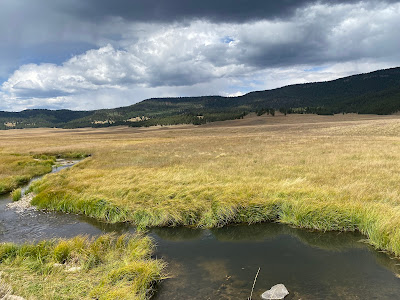Small Streams
Now, New Mexico is different than Colorado in some ways. Why? Well, Colorado's small streams do hold more large trout than what you will find in New Mexico's small streams. That's a fact, and as a result, it can be fun to go dry fly fishing in the high country of Colorado. Yes, I do that a few times each year. Please know, I'm perfectly satisfied with landing the Leetle Fellers in the Rios of New Mexico, but wow are the trout big and beautiful in those Colorado streams! And to hedge your bet for a fun day of fishing, rig up an ultra-light fly rod, to make it an exciting day in those small streams with pretty wild trout.
As of now, I want to spend the rest of my retirement days mostly on small streams when fly fishing. The rhythm of the cast, the dry fly floating down a feeding lane, and the splash of a little wild trout taking the fly is enough for me. The type of river that is exciting for me to fish is a small stream within some mountain range of New Mexico or Colorado. Why? The trout in these streams almost always rise to a dry fly. I love those low flows of about 12 inches over flat rocky shelves with riffles, accompanied by a deeper run flowing along the side of a bank. Also, streams with plunge pools above the head of a deep run and then tailing out into a wide section of riffles. Perfect! I also enjoy very much the pocket waters of high altitude Rios that cascade down the side of a mountain. Photographs probably illustrate my kind of streams better than my descriptions. So I've included a few.
Usually, we are catching small trout in these small streams of New Mexico. Well, yeah for the most part. Some large trout are in there. However, those bigguns are smart and hiding in the under cut of the bank, or deep in a pool. A nymph or streamer is the better bet to get to those bigger trout and fool them. It's just that, I don't fish that way anymore...so, it's kind of rare I get those large trout to take my dry fly. I'm okay with that, because the smaller trout in the 8 to 14 inch range makes my day of fly fishing quite satisfying, thank you.
I want to point out that just because I'm dry fly only in my fly fishing adventures, don't think I'm a purist or one of the elite in any way. No. I think of my dry fly only commitment as being more practical and besides, it's just more fun! I spend far fewer moments on the stream re-rigging my flies and leaders than those who fish the depths of a stream with below-surface flies. My dry flies don't get hung up in the stream bed on boulders or in tree branches that have been wedged into the streambed after runoff each year. Nope, my fly floats over all of that. I know for a fact I spend far less time rigging up and more time fishing with a dry fly than if I were fishing under water. And, I lose fewer flies as well. Besides, what can be better than seeing a trout rise from the bottom of the stream to take the fly with a splash of the take?










Comments
Post a Comment